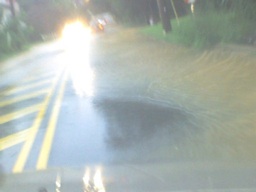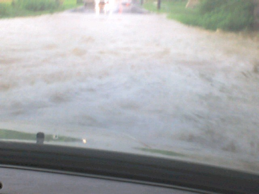
We’ve had the most drenching rains that I’ve ever seen in my life this summer where I live (Philadelphia). The sheer volume and force of water that has fallen out of the sky—I know this is a problem many areas of the country wish they had the last few summers—has whelmed previously dry places like the skylight flashing in my roof and the yards and basements of houses around me. (Photos taken while returning from a home center errand a few months ago.)
When I re-roof the house I’m adding another layer of flashing to the Velux skylight heads (stay tuned). But it is the yards and basements that have caught my eye lately, notably one house I pass all the time.
Water rushing down the hill its built into—and in the ground water—has found its way into the home so they dug up the entire back yard and installed a French drain. An excavator cut in the trench. The machine also wore a path from the front into the back and all of it needs new topsoil and seeds, which it got.


There’s nary a sprinkler in sight and—news flash—the grass won’t grow by magic. So, the takeaway: water new grass seeds, even if it’s just patching up bare spots.
I use the Gilmour Turbo Nozzle. It’s a fire-hose nozzle style for the garden hose. Duluth trading Company also sells one. You can get it to spray gently for newly seeded areas (I actually use a different Gilmour nozzle for misting, the Gilmour 327 . Yes…I am a total landscape dweeb) but what I really get a lot of mileage out of is that once things are a little established, I can drop a ton of water quickly with the fire-hose nozzle. It saves loads O’ time. I use it for flowers, trees and grass. For larger areas, I use a spike sprinkler—metal ones usually work best.
Going to all the trouble of raking out the soil and planting the seed is a waste without water.
